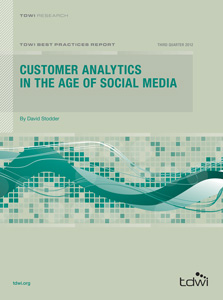
Customer Analytics in the Age of Social Media: Executive Summary
Customer analytics is about implementing technologies and methods for knowing more about customers’ behavior, their paths to purchasing goods and services, and what actions will engender greater loyalty among those who are most valuable. This new research reveals best practices, barriers, and benefits.
- By David Stodder
- July 2, 2012
 Becoming “customer centric” is a top priority today, and for good reason: as if it weren’t important enough that customers buy products and contract for services, they now do much more than simply buy. Customers participate in social media networks and chat rooms; they write blogs and contribute to comment sites; and they share information through sites such as YouTube and Flickr. Their activities and expressions not only reveal personal buying behavior and interests, but they also bring into focus their influence on purchasing by others in their social networks.
Becoming “customer centric” is a top priority today, and for good reason: as if it weren’t important enough that customers buy products and contract for services, they now do much more than simply buy. Customers participate in social media networks and chat rooms; they write blogs and contribute to comment sites; and they share information through sites such as YouTube and Flickr. Their activities and expressions not only reveal personal buying behavior and interests, but they also bring into focus their influence on purchasing by others in their social networks.
Social media networks have given organizations exciting new channels for marketing and customer engagement. Just as important, however, is that by creating data trails in social media networks, participants generate new types of data that hold great potential for customer insight. Advanced analytics technologies, modern data management and integration systems, and growing “big data” sources are enabling organizations to gain far greater depth and breadth of knowledge about customers, influencers, prospects, and the competitive marketplace. Social media data analysis can expand customer analytics by providing an unfettered, outside-looking-in view of an organization’s brands, products, services, and competitors.
This TDWI Best Practices Report examines organizations’ current practices and future plans for customer analytics technology implementations, with a special focus on how organizations are adapting to the knowledge potential as well as challenges of social media networks. The report offers recommendations for achieving greater return on investment (ROI) from customer analytics processes. This higher return is important because marketing functions are being held more accountable for the effectiveness of campaigns in delivering on financial objectives and their measurable impact on overall business growth. Business functions need customer insights not just for marketing campaigns, but also for informing the organization’s sales, service, support, product development, and other key functions about customer feedback and trends.
Customer analytics, seasoned with insight from social media data, can enable organizations to make faster strides in predicting retention, attrition, and return rates, with the goal of reducing customer churn. Analytics can improve how organizations decide on characteristics for customer segmentation; social media can provide clues to emerging characteristics for definition of new segments. Firms can employ predictive modeling to test and learn from campaigns so that they are able to select the most persuasive offers to put in front of the right customers at the right time.
Speed is a competitive advantage in marketing. If an organization can analyze data faster and feed insights more frequently to its customer relationship management (CRM), marketing optimization, and campaign management applications, it will realize advantages over firms that are locked into seasonal campaigns, do not analyze customer behavior data, or are too slow in analyzing it. This report explores how organizations can use analytics to discover much sooner which message, interaction, or campaign actually had the most influence on triggering a customer purchase rather than attributing it blindly to the last thing that a customer did or saw.
Organizations are thus focused on evaluating and deploying a new breed of analytics and data management technologies to increase the speed of analysis and reduce latency in applying knowledge to marketing actions. These technologies include analytic databases, columnar databases, Hadoop and MapReduce, customer master data management (MDM), and predictive analytics tools.
Nontechnical users in marketing and other functions are implementing social media analytics, business intelligence, data discovery, and visual analysis products to allow them to consume insights more easily and explore data on their own.
Greenplum, a division of EMC; IBM; Informatica; SAP; SAS; Tableau Software; Teradata (including Teradata Aster and Aprimo); and Vertica, an HP Company, sponsored the research for this report.
About the Author
David Stodder David Stodder is an independent data and analytics industry analyst. Previously, he was senior director of research for business intelligence at TDWI, where he spent more than 13 years. Stodder focuses on providing research-based insights and best practices for organizations implementing BI, analytics, AI, data intelligence, data integration, and data management. He has been a thought leader in the field for over three decades as an industry analyst, writer, and speaker. He was the founding chief editor of Intelligent Enterprise where he also served as editorial director for nine years. Stodder is a TDWI research fellow.